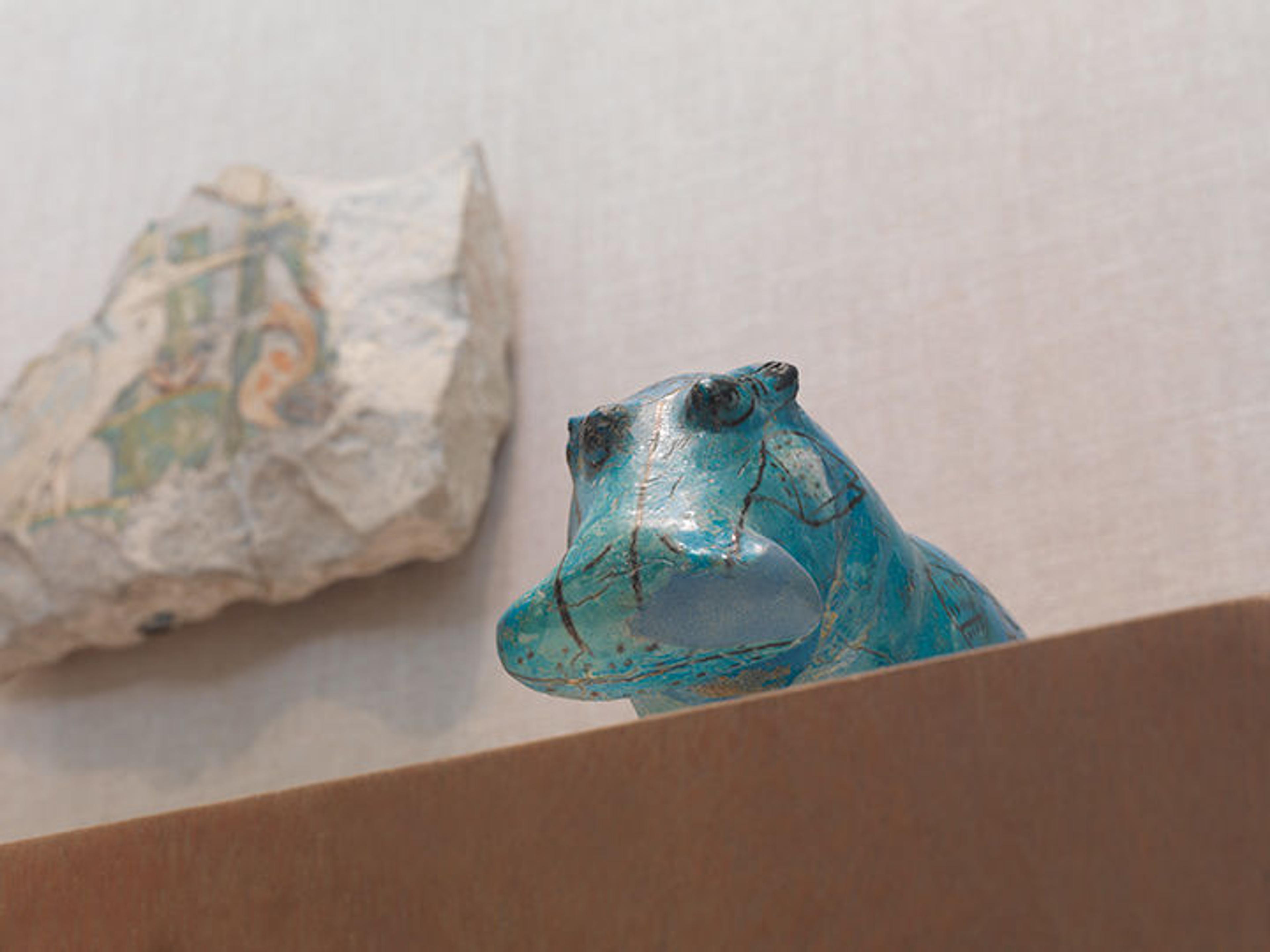
William looks down from his perch in the galleries
«In spite of his popularity, there is much we don't know about William the hippo. What methods were employed nearly 4,000 years ago to form, glaze, and fire this lovable Egyptian faience creature, who came to The Met in 1917? In honor of his 100th anniversary at the Museum, William paid a visit to the Department of Objects Conservation. Although we've examined some wonderful ancient Egyptian faience objects, we'd only admired William through a glass case, so it was exciting to have him in the lab in person!»
William is fashioned from Egyptian faience, a ceramic material with a siliceous body and a translucent glaze, most commonly turquoise blue or green in color. Made primarily of silica sourced from quartz pebbles and sand, faience contains several other components, including water-soluble alkaline salts, such as the carbonates of sodium, and lime. The Egyptians used various colorants for the glazes, including copper minerals, which produced the most commonly seen turquoise. These dry ingredients, ground into a fine powder, were then mixed with water to create a thick paste.

Faience replication in the Department of Objects Conservation, demonstrating the thixotropic nature of the wet faience paste
Once wet, the differences between faience and clay are immediately apparent. Wet faience paste displays an interesting quality known as thixotropy. When a force known as a "shear" force—a side-to-side movement, for example—is applied to the paste, it becomes more fluid and slumps. Faience paste, unlike clay, is non-plastic. It cracks when folded, and it cannot support its own weight. Due to these limitations, there are fewer methods for shaping faience than for clay. The paste can be modeled by hand or pressed into fired-clay molds; wet faience can also be worked into a slab by shaking and patting; or the paste can be formed around a combustible core.

Faience replication experiment: paste during the drying process (left), and after firing (right)
In ancient times, faience was glazed using three different techniques: efflorescence, cementation, and direct application. The efflorescence technique can be described as "self-glazing," because the colorant is added to the wet paste and migrates to the surface along with the alkaline salts as the faience dries, forming a salty crust. During firing, this layer reacts with the finely ground silica and lime to form a glaze. Cementation is another self-glazing technique. Here, the unglazed faience core is buried in a "glazing powder" before being placed in the furnace. After firing, the crusty powder is broken away to reveal a glazed surface. Finally, the direct-application technique more closely resembles typical ceramic methods of applying liquid glaze to a fully formed object. Once dry, the pieces must be fired in a kiln (between 870º C and 920º C) to reveal their brilliant color.[1]
To learn more about the specific materials and methods used to make William, who was found at Meir in Middle Egypt and dates to the early Twelfth Dynasty (ca. 1961–1878 B.C.), we began by performing visual observation with a stereomicroscope. Conservators use this instrument to get a closer look at surface details, which can help them better understand how an object was made and its state of preservation.

A rare glimpse of William's belly
One of the interesting details we noted when we looked at William's underside was a series of textured patches. Under the microscope, we saw that these areas had almost no glaze. Their rough texture suggests contact with kiln furniture, used to support the figure during drying and firing. Often the presence of such textured patches is associated with the efflorescence glazing method. However, a similar texture can also form on larger objects glazed with the cementation method, where the glazing powder cracks during firing. The unevenness of William's glaze seems to indicate efflorescence, but the presence of some especially deep recesses with almost no glaze points to cementation. It is also possible that the maker employed a combination of both methods.
In addition to visible light, another common tool conservators use to examine objects is ultraviolet (UV) radiation, which has a shorter wavelength than visible radiation and is invisible to the naked eye. When exposed to UV, atomic particles of certain materials are stimulated, and in a darkened room they appear to glow. This property is called fluorescence: think of how a white t-shirt glows under a black light. Because materials fluoresce with different colors and intensities, UV can help us detect modern coatings and restorations.
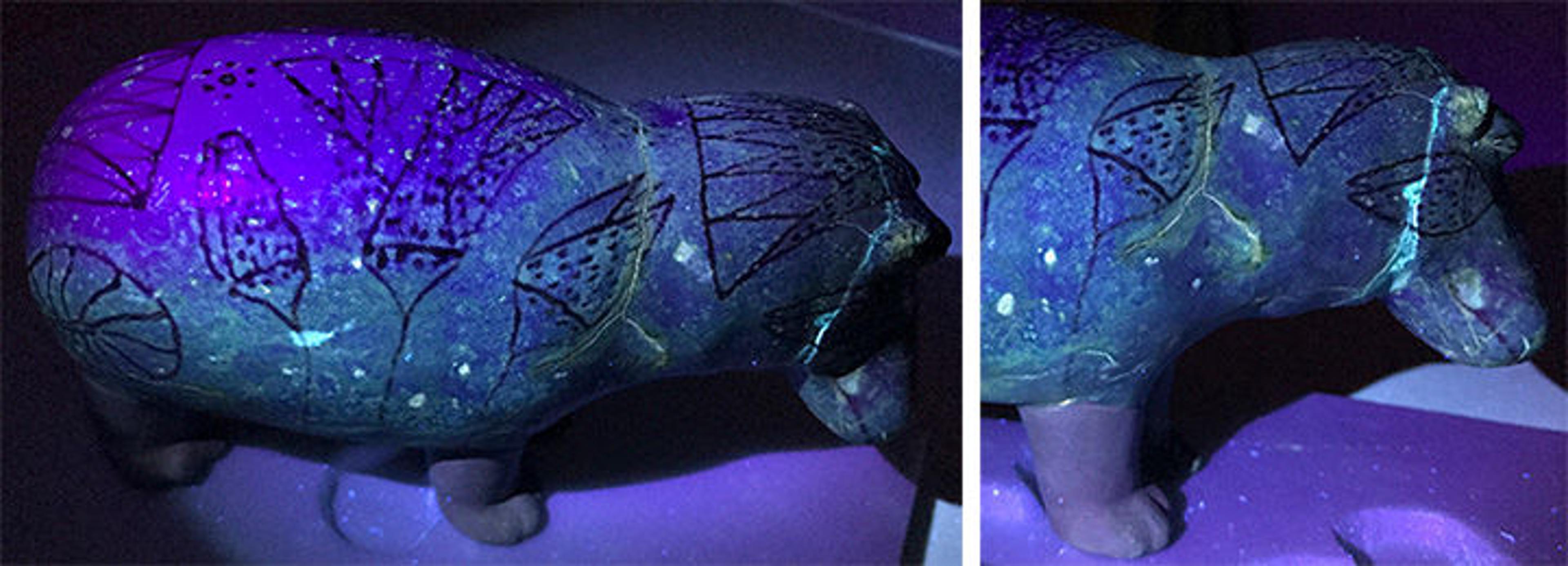
William viewed under a UV lamp
Under UV we could view the extent of William's restorations and make observations about the nature of materials present. The bright white fluorescence you see around William's neck and at the top of three of his legs (which we know were restored) provide clues to the identity of the modern adhesive in these areas. Other cracks and shallow losses on William's body also fluoresced white; this fluorescence, however, probably corresponds to the mineral calcite, which is a source of lime in the faience body. The fluorescence of the body also helped us to gauge differences in glaze thickness: thicker areas of glaze, which obscure the fluorescence, appear deep purple, such as on his back. These features were not visible in normal light.
We also x-rayed William. Whereas visible light and ultraviolet radiation allow us to see features on an object's surface, radiography helps us to look inside. X-rays are a high-energy form of electromagnetic radiation that can penetrate matter, and the degree of penetration depends on the thickness of the object and the material from which it is made.
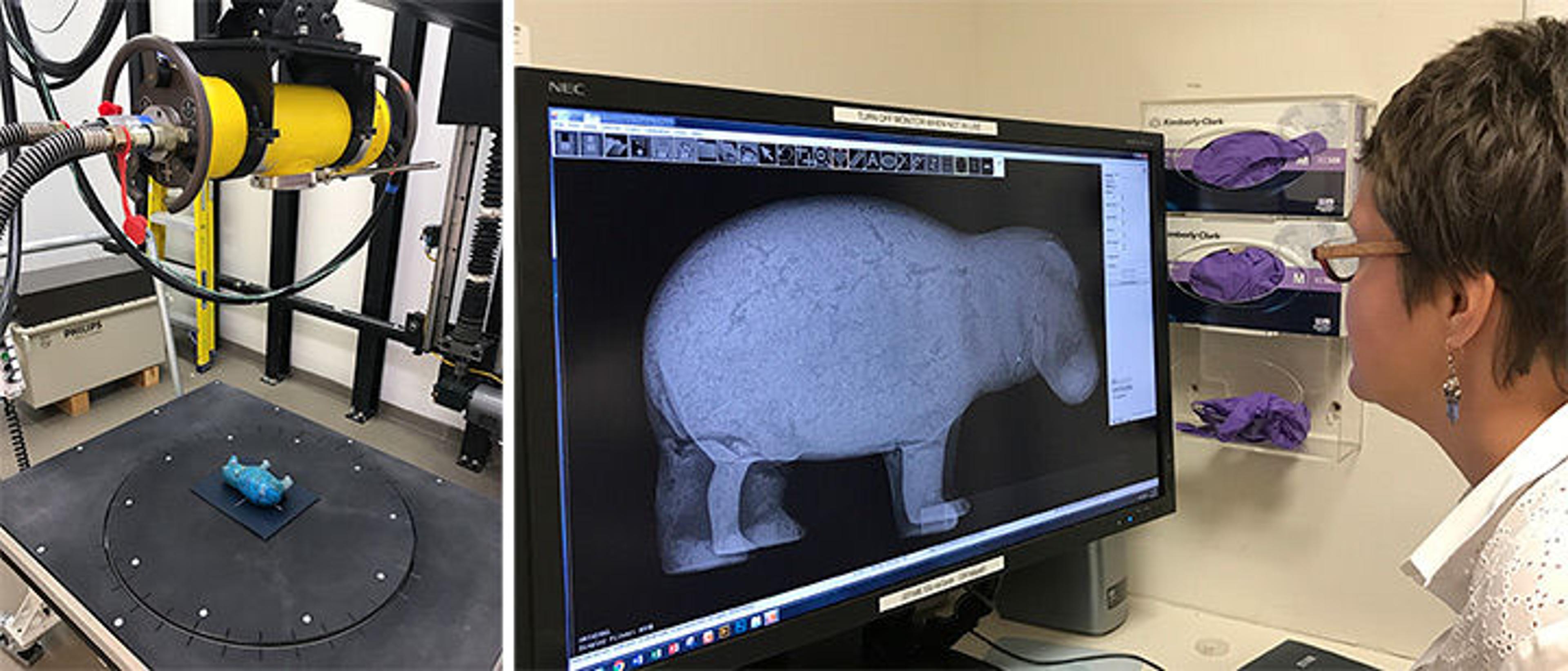
Left: William positioned under the x-ray tube in the Objects Conservation Department. Right: Conservator Carolyn Riccardelli looks at a computed radiograph of William
X-rays of objects are just like x-rays of people. Traditionally, radiation was used to expose a special photographic film that was placed behind the object; the film was then developed in a darkroom, just like a black-and-white photograph. Nowadays, most doctors and many conservators use digital systems to produce computed radiographs, replacing the film with a light-sensitive imaging plate that is processed in a special scanner and viewed on a computer screen.
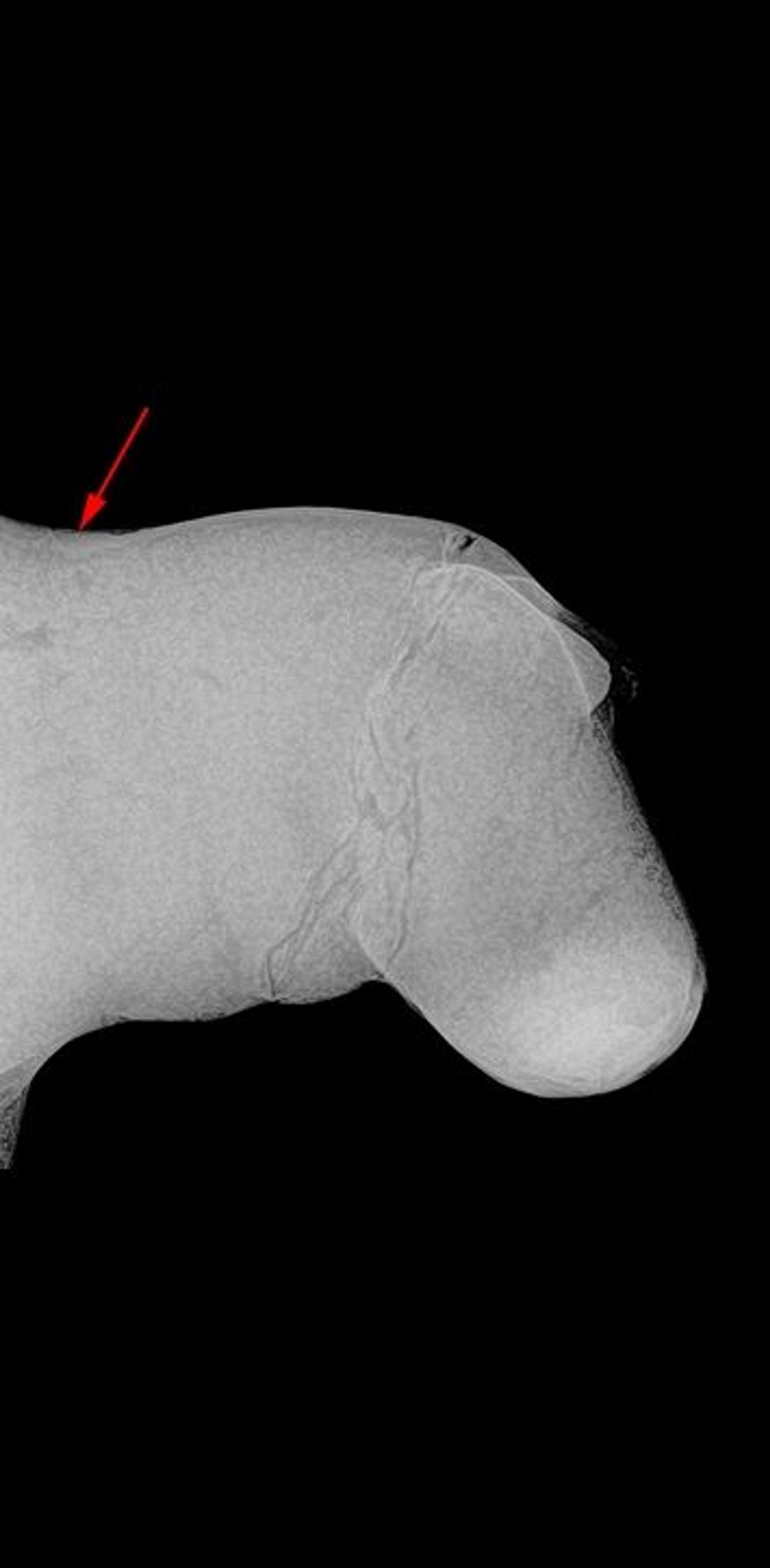
Left: Profile radiograph of William's head and neck, processed to increase contrast. The fine-grained outer layer is visible along the top of William's head and neck
Radiographic images reveal how different materials or different volumes of the same material interact with the x-ray radiation. When we x-rayed William, we observed a thin, dense layer between his mottled core and glazed surface. This is probably faience that was more finely ground and contains whiter quartz particles than the core. Such layers, which were applied intentionally, presumably for their optical quality, have been observed in faience objects from the Middle Kingdom onward.[2] At left, you can see the layer, particularly where it is thicker at the base of his neck.
To complement visual observation and imaging, conservators also use a variety of analytical techniques to identify the particular elements or compounds present. One such technique is x-ray fluorescence spectroscopy (XRF). With this technique, x-rays generated by a spectrometer interact with the surface of a material, causing atoms present to emit radiation at characteristic wavelengths. This emission is detected by the device and can be attributed to specific elements.
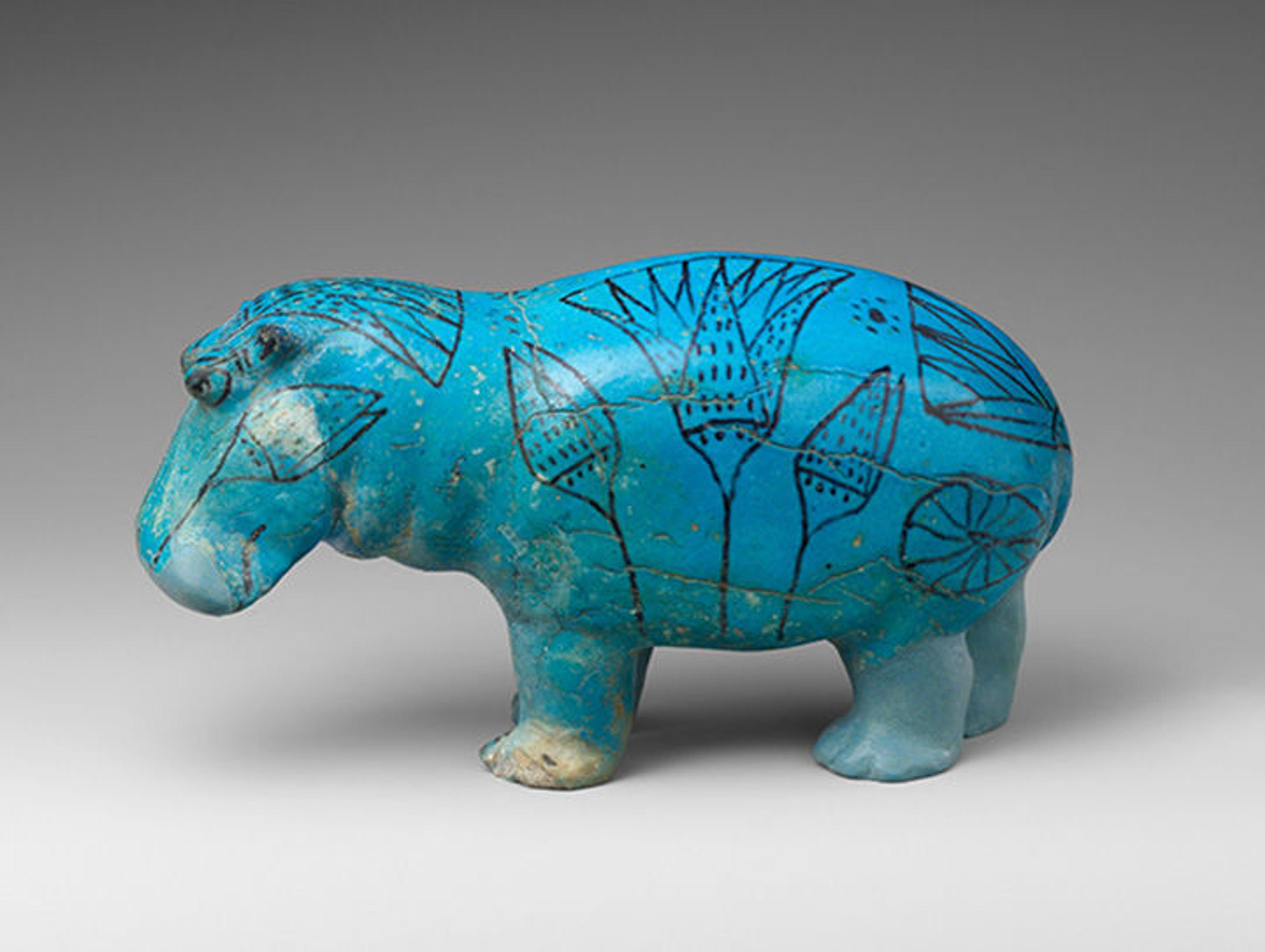
William the hippopotamus. Middle Kingdom, Dynasty 12, reign of Senwosret I to Senwosret II (ca. 1961–1878 B.C.). Faience. From Egypt, Meir, tomb B3; Said Bey Khashaba excavations, 1910. The Metropolitan Museum of Art, New York, Gift of Edward S. Harkness, 1917 (17.9.1)
We used XRF to determine whether a brown layer we observed on the bottom of William's single surviving leg was applied in ancient or modern times. The analysis suggested that this surface has indeed been restored: there were levels of lead, iron, and calcium far higher than those associated with an ancient glazed surface. Analysis of William's blue glaze revealed elements typical for Egyptian faience, including copper, silica, and calcium. When we analyzed one of the lotus plants painted on William's back, we saw the element manganese, which was used as a colorant for black faience glazes. These results are not quantitative, but they do give us a general idea of the elements present on the surface; and the differences in composition we observed allowed us to document a previously unnoticed area restored in modern times.
What did we learn about William during his brief visit to the lab? We were better able to visualize the extent of modern restoration, and we observed and documented previously unrecorded manufacturing features such as the firing marks, the fine quartz layer, and variations in glaze thickness. We also confirmed that, in general, he's fairly typical of Middle Kingdom faience. However, when a conservator examines an object in depth, often more questions are raised than answered. While we understand the fundamentals of faience making, our experience with replicating faience and our study of other faience objects have shown us that there are details about faience production that we still don't understand. How, exactly, was an object as large as William made from a thixotropic, difficult-to-work paste? Was William formed in stages to facilitate modeling? Were organic materials, which we can no longer detect, added to the faience paste to make it easier to work? In our final estimation, William is just as engaging up close, but still quite mysterious.
[1] Charles Kiefer and A. Allibert, "Pharonic Blue Ceramics: The Process of Self-glazing," Archaeology 24 no. 2 (1971): 107–17; and Pamela B. Vandiver, "Technological Change in Egyptian Faience," in Archaeological Ceramics, ed. Jacqueline S. Olin and Alan D. Franklin (Washington, D.C.: Smithsonian Institution Press, 1982), 167–79.
[2] Pamela B. Vandiver, "A Review and Proposal of New Criteria for Production Technologies of Egyptian Faience," in La Couleur dans la Pienture et l'Emaillage de l'Egypte Ancienne, ed. Sylvie Colinart and Michel Menu (Bari: CUBEC, 1998): 121–38.
William the Hippo: Celebrating 100 Years at The Met

#William100